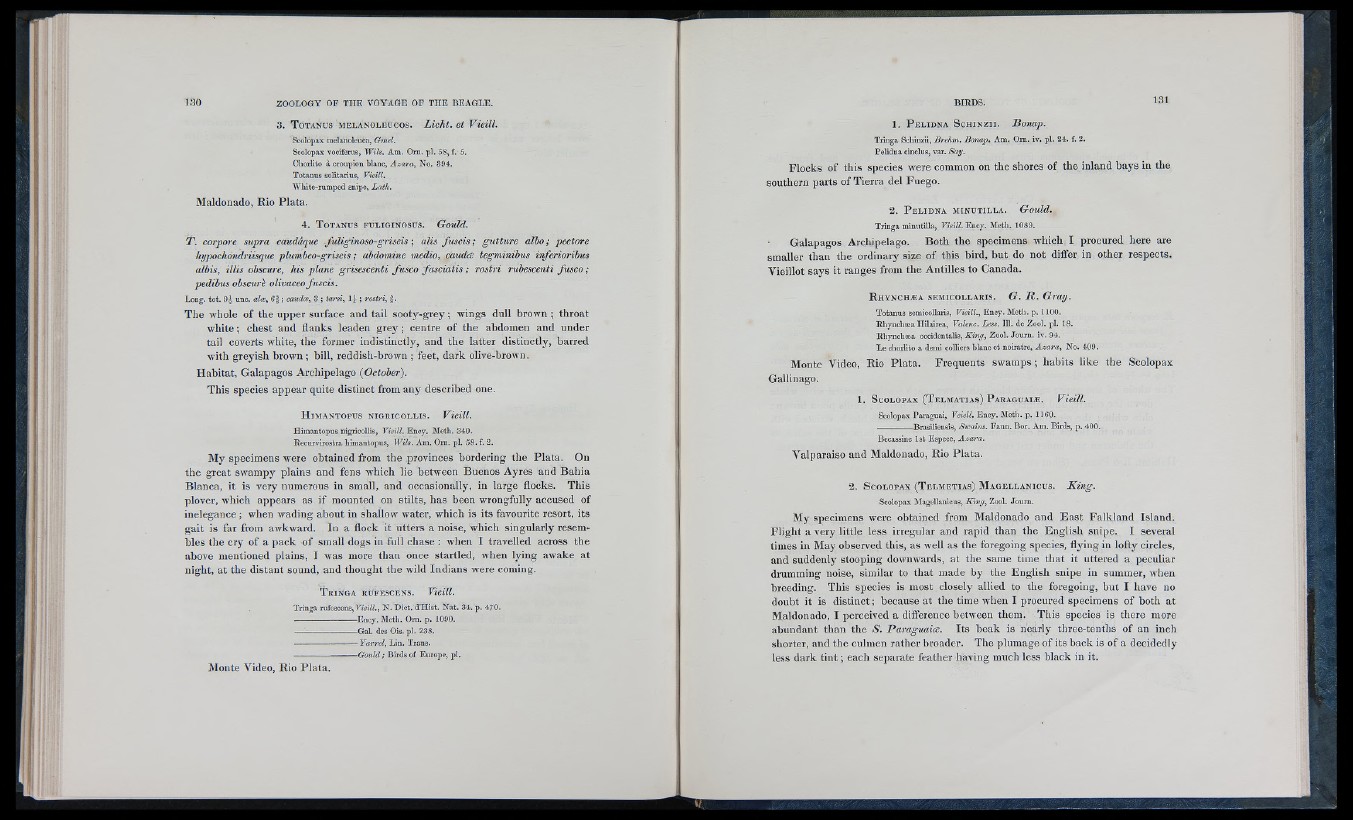
3 . T o t a n u s m e l a n o l e u c o s . Licht. et Vieill.
Scolopax raelanoleuca, Gmel.
Scolopax Tociferus, Wils. Am. Orn. pl. 58, f. 5.
Chorlito à croupion blanc, Azara, No. 894.
Totanus solitarius, Vieill.
aVhite-rumped snipe, Lath.
Maldonado, Rio Plata.
4 . T o t a n u s f u l ig i n o s u s . Gould.
T. corpore supra caudâque fuliginoso-griseis \ alis fuscis; gutture alho; pectore
hypochondriisque plumbeo-griseis ; abdomine medio, caudæ tegminibus inferioribus
albis, illis obscure, his plane grisescenti fusco fasciatis; rostri tubescenti fis c o ;
pedibus obscurè oliváceo fuscis.
Long. tot. 9 | unc. aloe, 6 | j caudæ, 3 ; tarsi, G ; rostri,
The whole of the upper surface and tail sooty-grey; wings dull brown; throat
white ; chest and flanks leaden grey ; centre of the abdomen and under
tail coverts white, the former indistinctly, and the latter distinctly, barred
with greyish brown; bill, reddish-brown ; feet, dark olive-brown.
Habitat, Galapagos Archipelago {October).
This species appear quite distinct from any described one.
H im a n t o p u s n i g r i c o l l i s . Vieill.
Himantopus nigricollis, Vieill. Ency. Meth. 340.
Recurviiostra himantopus, TDVi. Am. Om. pl. 58. f. 2.
My specimens were obtained from the provinces bordering the Plata. On
the great swampy plains and fens which lie between Buenos Ayres and Bahia
Blanca, it is very numerous in small, and occasionally, in large flocks. This
plover, which appears as if mounted on stilts, has been wrongfully accused of
inelegance ; when wading about in shallow water, which is its favourite resort, its
gait is far from awkward. In a flock it utters a noise, which singularly resembles
the cry of a pack of small dogs in full chase : when I travelled across the
above mentioned plains, I was more than once startled, when lying awake at
night, at the distant sound, and thought the wild Indians were coming.
T r in g a r u f e s c e n s . Vieill.
Tringa rufescens, Vieill., N. Diet. d’Hist. Nat. 34. p. 470.
----------------------- Ency. Meth. Om. p. 1090.
----------------------- Gal. des Ois. pi. 238.
------------------------Yarrel, Lin. Trans.
Monte Video, Rio Plata.
-G o u ld ; Birds of Europe, pl.
1 . P e l i d n a S c h i n z i i .
Tringa Schinzii, Brehm. Bonap. Am. Ora. iv. pl. 24. f. 2.
Pelidna cinclus, var. Say.
Flocks of this species were common on the shores of the inland bays in the
southern parts of Tierra del Fuego.
2 . P e l i d n a m i n u t i l l a . Gould.
Tringa minutilla, Vieill.Vi'acy. Meth. 1089.
Galapagos Archipelago. Both the specimens which I procured here are
smaller than the ordinary size of this bird, but do not differ in other respects.
Vieillot says it ranges from the Antilles to Canada.
Rhynchæa SEMicoLLAnis. G .R .G r a y .
Totanus semicoUaris, Vieill., Ency. Meth. p. 1100.
Rhynchæa Ililairea, Valenc. Less. 111. dc Zool. pl. 18.
Rhynchæa occidentalis. King, Zool. Joum. iv. 94.
Le chorlito a demi colliers blanc et noirâtre, A zara, No. 409.
Monte Video, Rio Plata. Frequents swamps ; habits like the Scolopax
Gallinago.
1 . S c o l o p a x ( T e l m a t i a s ) P a r a g u a iæ . Vieill.
Scolopax Paraguai, Veiell. Ency. Metli. p. 1160.
------------- Brasiliensis, Stcains. Faun. Bor. Am. Birds, p. 400.
Bccassine 1st Espece, Azara.
Valparaiso and Maldonado, Rio Plata.
•2. S c o l o p a x ( T e l m e t ia s ) M a g e l l a n i c u s . King.
Scolopax Slagellanicus, King, Zool, Journ.
My specimens were obtained from Maldonado and East Falkland Island.
Flight a very little less irregular and rapid than the English snipe. I several
times in May observed this, as well as tlie foregoing species, flying in lofty circles,
and suddenly stooping downwards, at the same time that it uttered a peculiar
drumming noise, similar to that made by the English snipe in summer, when
breeding. This species is most closely allied to the foregoing, but I have no
doubt it is distinct; because at the time when I procured specimens of both at
Maldonado, I perceived a diflerence between them. This species is there more
abundant than the S. ParaguaicB. Its beak is nearly three-tenths of an inch
shorter, and the culmen rather broader. The plumage of its back is of a decidedly
less dark tin t; each separate feather having much less black in it.